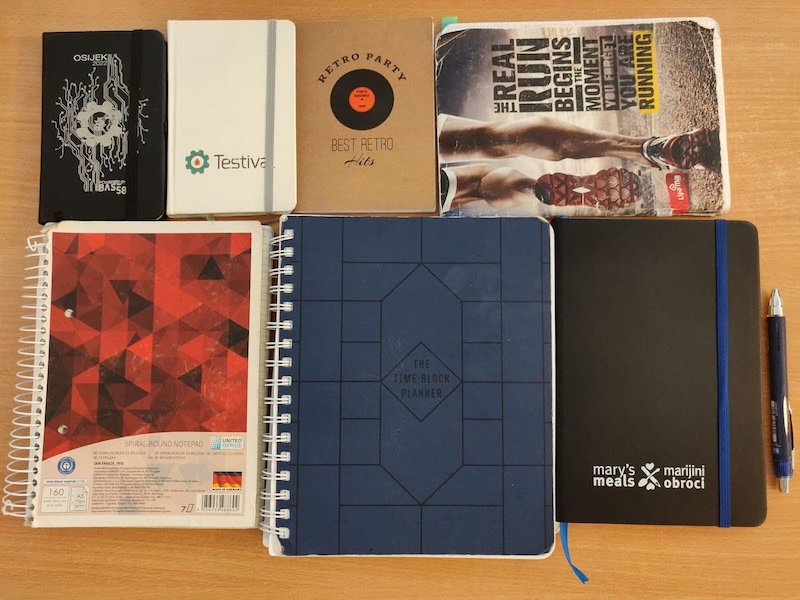The Time-Block Planner by Cal Newport
by Željko Filipin

Various notebooks I have used over the years.
Introduction
I’m very interested in personal productivity. Two authors that have deeply influenced me in that area are David Allen (of Getting Things Done fame) and Cal Newport (of Deep Work fame).
Multi-Scale Planning
Both Allen and Newport agree that planning is necessary on multiple levels. You need a daily plan, a weekly plan, a monthly plan, a quarterly plan, a yearly plan, a multi-year plan — this is a concept known as multi-scale planning.
Finally, you have to figure out what is ultimately important to you. Why are you even planning? What are the important areas in your life? What is more important to you: family, health, work…? In which order? How will all the planning you do get you to your goal, whatever it is?
Allen says your contexts have to be up to date and he insists on doing a weekly plan. That’s what I did for years, if not decades.
Newport goes further and insists that you need a daily, a weekly and a quarterly plan. Since I was already familiar with the weekly planning, it wasn’t such a stretch for me to implement a daily and a quarterly planning routine. To my big surprise, it changed my life.
Time Blocking
Time blocking is part of multi-scale planning. Time blocking is an important part of the daily plan. Decide, in advance, when you will start working that day and when you will stop working. In the part of the day that you work, give every minute a job. The plan includes all meetings from your calendar. You even plan your breaks.
Some important notes.
- You can make the daily plan whenever it makes sense for you. I usually create the plan for the next day in the evening of the previous day. You could also do it first thing in the morning, or the first thing when you start working.
- You only time block your working day, not the portion of the day before and after it. The reason is that time blocking is hard. Too much of it would be unsustainable for a long time.
- The plan is not written in stone. You’re free to change it. Life happens. It’s more important to have a plan than it is to stick to it.
- At the end of the time-blocked portion of the day, do a quick review and a shutdown routine. That allows your mind to switch from work mode to rest mode.
I’ve noticed that I enjoy the deep work sessions so much that I schedule too many of them. Unfortunately, life is not all about deep work. There’s shallow work that needs to be done. Shallow work is important too, if not that enjoyable.
Time blocking makes it explicit how much time I spend on deep work and how much on shallow work.
Time blocking is an important tool to help me focus during work hours. The focus allows me to get enough done during work that I don’t have to think about work later. I can rest.
Planners
I’ve used many planners. I remember that I had a planner at least in the eighth grade. I probably had one even before, but I distinctly remember having a planner then. (If your school system is different than it is in Croatia, I was about 14 years old in the eighth grade.)
Most planners I used over the years are smaller than this one. Some of them are significantly smaller.
These days, I have a separate (smaller, of course) planner for both my quarterly and weekly plans. It’s nice to be able to see both the weekly plan and the daily plan at the same time, without the need for flipping pages back and forth.
When I fill up my current quarterly and weekly planner I’ll buy two separate planners. One for the quarterly and one for the weekly plan. It would be nice to have both the quarterly and the weekly plan visible at the same time.
My Time With the Time-Block Planner
I used it in January and February 2024. In February and March I was on parental leave, so I didn’t need it. When I returned from the leave, I decided not to use it until I moved from the coworking space to my home office. (I was commuting to work by bike. The planner is so big that it was taking up too much space in my backpack.) In May I moved to the home office. In June I started using the planner again and I used all the pages in August.
The Time-Block Planner
I’m reviewing the second edition of The Time-Block Planner (2023). It has space for 16 weeks, or about 4 months. (I would love to take a look at the first edition (2020), out of curiosity.)
It’s mostly just an expensive notebook. The vast majority of the pages are empty. There are about twenty pages of text at the beginning and three pages of text at the end. But, that text alone is worth the price of the planner.
Quotes for Newport’s books are sprinkled here and there in the planner. Those are mostly inspirational snacks. You’ll enjoy them if you’re a Newport fan. (I surely am.)
There’s room for various notes on the left hand side. On the right hand side is the grid where you create a time block plan for the day.
Things I Didn’t Like
Daily metrics section (on the left hand side) is too small for me. I track way too many things daily. For example, how many hours of deep work happened that day.
Weekends don’t have the usual pages and I don’t like it. I don’t need the time-block grid for the weekend, but I do need more space for daily metrics and tasks that I’m planning for the weekend. There’s room for a weekly plan in the planner, but that’s way too little space for my weekly plan.
I prefer planners with hard covers. Sometimes I’m writing in it without a table around. My handwriting is not great. Planner with hard covers makes my handwriting at least readable in that case.
Conclusion
I’m glad I bought the planner. If you’re new to personal productivity or time blocking, buying this planner is a good investment.
The planner did help me get into the habit of quarterly, weekly and daily planning (with time blocking). But, it has served its purpose. I don’t really need another time-block planner. Any other planner would do. I don’t think I’ll buy another one. I prefer smaller planners that give me more flexibility.
But, will I buy the third edition of the planner when it’s published? Of course.

Duolingo reviews the planner.
Reviewers
A big thank you to Tyler Cipriani for great advice on how to make this post better.
tags: book - photo - productivity